I would like to calculate the mean value of the ratio [op/(tr - lag(tr))] for each year for the following data
structure(list(gvkey = c(1000L, 1000L, 1000L, 1000L, 1000L, 1001L,
1001L, 1001L, 1003L, 1003L, 1003L, 1003L, 1003L, 1003L, 1003L,
1004L, 1004L, 1004L, 1004L, 1004L, 1004L, 1004L, 1004L, 1004L,
1004L, 1004L, 1004L, 1004L, 1004L, 1004L, 1004L, 1004L, 1004L,
1004L, 1004L, 1004L, 1004L, 1004L, 1004L, 1004L, 1004L, 1004L,
1004L, 1004L, 1004L, 1004L, 1004L, 1004L, 1004L, 1004L, 1004L,
1004L, 1004L, 1004L, 1004L, 1004L, 1004L, 1004L, 1004L, 1004L,
1004L, 1004L, 1004L, 1005L, 1005L, 1005L, 1005L, 1005L, 1005L,
1005L, 1005L, 1006L, 1006L, 1006L, 1006L, 1006L, 1006L, 1006L,
1006L, 1006L, 1007L, 1007L, 1007L, 1007L, 1007L, 1007L, 1007L,
1007L, 1007L, 1007L), fyear = c(1973L, 1974L, 1975L, 1976L, 1977L,
1983L, 1984L, 1985L, 1983L, 1984L, 1985L, 1986L, 1987L, 1988L,
1989L, 1973L, 1974L, 1975L, 1976L, 1977L, 1978L, 1979L, 1980L,
1981L, 1982L, 1983L, 1984L, 1985L, 1986L, 1987L, 1988L, 1989L,
1990L, 1991L, 1992L, 1993L, 1994L, 1995L, 1996L, 1997L, 1998L,
1999L, 2000L, 2001L, 2002L, 2003L, 2004L, 2005L, 2006L, 2007L,
2008L, 2009L, 2010L, 2011L, 2012L, 2013L, 2014L, 2015L, 2016L,
2017L, 2018L, 2019L, 2020L, 1974L, 1975L, 1976L, 1977L, 1978L,
1979L, 1980L, 1981L, 1974L, 1975L, 1976L, 1977L, 1978L, 1979L,
1980L, 1981L, 1982L, 1974L, 1975L, 1977L, 1978L, 1979L, 1980L,
1981L, 1982L, 1983L, 1984L), ppent = c(7.408, 5.691, 7.263, 16.44,
19.917, 8.536, 12.715, 22.411, 0.256, 0.424, 0.893, 1.036, 1.179,
1.076, 0.654, 4.258, 4.746, 5.652, 6.016, 8.272, 11.142, 13.548,
14.405, 32.531, 31.946, 33.648, 34.466, 38.614, 44.342, 46.938,
50.77, 63.441, 63.415, 60.422, 56.052, 54.783, 56.596, 54.831,
71.108, 82.905, 104.012, 110.003, 108.907, 102.591, 166.761,
166.137, 139.137, 213.38, 260.167, 310.393, 245.586, 334.43,
417.764, 456.015, 426.4, 413.3, 295, 313.9, 361.5, 316.6, 348.8,
437.1, 380.1, 1.159, 1.269, 1.348, 1.498, 2.292, 2.793, 4.908,
6.662, 0.281, 0.22, 0.238, 0.379, 0.385, 0.362, 0.322, 0.281,
0.381, 0.367, 0.315, 0.258, 0.238, 0.203, 0.178, 0.17, 0.095,
0.064, 0.286), aqc = c(0, 1.652, 0, 5.443, 5.447, 0.238, 0.034,
17.931, 0, 0, 2.875, 0, 0, 0, 0, 0.653, 0, 0, 0, 2.077, 0, 0,
0.629, 18.727, 1.713, 1.152, 0, 0, 0, 2.749, 2.397, 0, 0, 0,
0, 0, 0, 0, 0, 28.148, 15.175, 0, 3.2, 13.251, 0, 0, 0, 0, 38.478,
85.21, 0, 193.989, 0, 298.087, 21.3, 15.3, 1, 0, 12.5, 22.9,
2.3, 0, 0, 0, 0, 0, 0, 0, 0.133, 0.107, 0.142, 0, 0, 0, 0, 0,
0, 0, 0, 0, 0, 0, 0, 0, 0, 0, 0, 0, 0, 0)), row.names = c(NA,
90L), class = "data.frame")
I would like an answer using dplyr
I apply the following code as suggested but it gives me wrong values as shown below. I have tried to calculate the median and then it gives me 0 for all years.
medianaqcproportion <- cleanData %>%
group_by(gvkey) %>%
mutate(lagppent = lag(ppent)) %>%
group_by(fyear) %>%
summarize(ans = mean(aqc / (ppent - lagppent), na.rm = TRUE), .groups = "drop")
